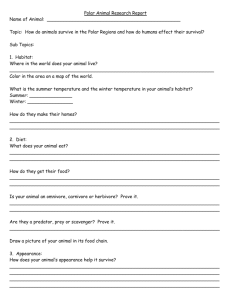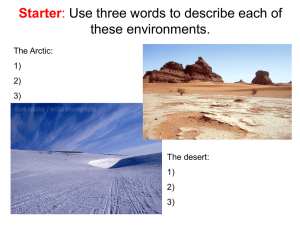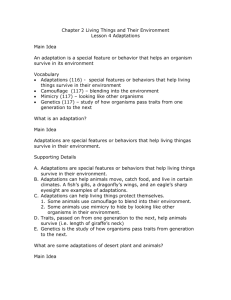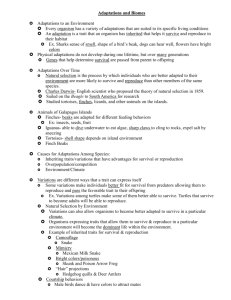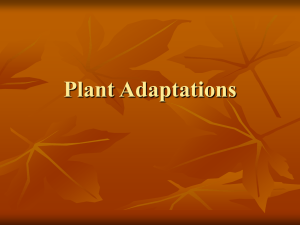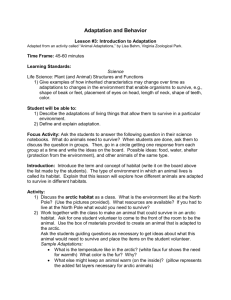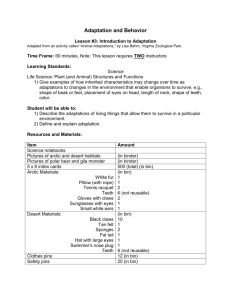B1.14_(&B1.16)_Adaptations_in_Plants
advertisement
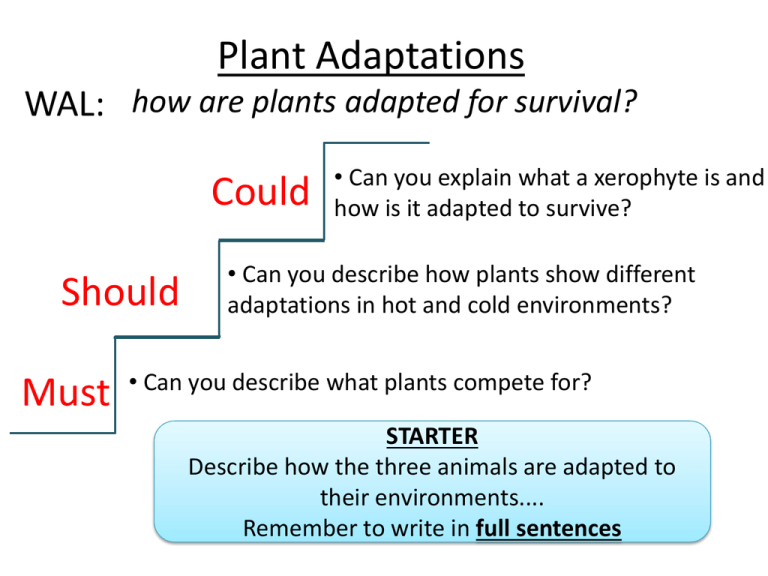
Plant Adaptations WAL: how are plants adapted for survival? Could Should Must • Can you explain what a xerophyte is and how is it adapted to survive? • Can you describe how plants show different adaptations in hot and cold environments? • Can you describe what plants compete for? STARTER Describe how the three animals are adapted to their environments.... Remember to write in full sentences What do plants need to survive? • Hint: take a look at page 50… What do plants need to survive? 1. 2. 3. 4. Light Space Water Nutrients From the soil So many different environments – but plants in nearly all of them! mountainside – cold and dry with snow in winter savannah – warm and dry except in the rainy season desert – hot and dry rainforest – warm and wet arctic – very cold and dry woodland – cool and wet The problem with leaves! • Plants need leaves as they absorb the sunlight they require to make their own food via photosynthesis. • However, a lots of water can be lost through the leaves via pores. The problem with leaves! • Plants need leaves as they absorb the sunlight they require to make their own food via photosynthesis. • However, a lots of water can be lost through the leaves via pores. How can a smaller surface area help reduce this problem? What is a xerophyte? Clue: an example would be a cactus! What is a xerophyte? A xerophyte is a plant which is adapted to live in dry or desert areas. Core, challenge or super-challenge? Look at the adaptations to dry environments on page 47. Choose which level you think you are working at. 10 minutes Core – Grade C 1. State the adaptations that help marram grass live in dry soil. 2. Beaches are often windy environments. Explain how the adaptations of marram grass help it survive the windy conditions. Challenge – Grade B 3. The pine tree and cactus both show similar adaptations of their leaves. Explain why the same adaptation helps plants survive in two very different environments. 4. Explain why a dandelion isn’t well adapted for living in the desert. Super-challenge – Grade A 5. Suggest a reason why flowering plants tend to reproduce more in the warmer summer months. 6. The acacia tree has a very long tap root. Explain how this adaptation helps it to survive on the African savannah. Core Challenge Superchallenge • Leaves are long thin spikes which reduces surface area and therefore water loss. • Leaves are rolled. Pores are on inside so this prevents water loss. •Waxy layer on outside prevents water loss. • Deep root system allows it to absorb water. • The long root anchors the grass into the ground so that it won’t blow away. • The leaves are long spikes which won’t get caught in the wind. • The leaves are rolled up so any water that is lost from the leaves won’t be blown away by the wind. There is not much water in the dessert and so the spines aid in reducing the amount of water loss from the cactus. Even though it is cold where the pine tree lives, the water freezes in winter so it cannot absorb water, so preventing water loss by having needles is an advantage. Dandelion’s are not well adapted for the desert as they don’t have long roots are would blow away. They also have no protection against predators from being eaten (e.g spines or poisonous chemicals). Their seeds would all blow away in the wind. Flowering plants tend to reproduce more in the summer months as the production of a flower would take a lot of energy and so a lot of sunlight would be needed to produce food for this. Also, flowers are for the purpose of pollination and there are more flying insects in the warmer summer months. The long root of the acacia tree helps it to survive in the African savannah as it rains there every few months and then is very dry. This means that it can get to the water supply deep underground where it is cooler and not evaporated by the hot sun.


